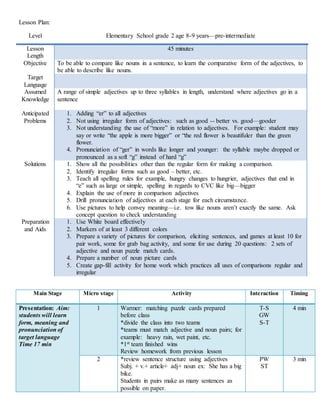
Lesson plan for adjectives
- 1. Lesson Plan: Level Elementary School grade 2 age 8-9 years—pre-intermediate Lesson Length 45 minutes Objective To be able to compare like nouns in a sentence, to learn the comparative form of the adjectives, to be able to describe like nouns. Target Language Assumed Knowledge A range of simple adjectives up to three syllables in length, understand where adjectives go in a sentence Anticipated Problems 1. Adding “er” to all adjectives 2. Not using irregular form of adjectives: such as good -- better vs. good—gooder 3. Not understanding the use of “more” in relation to adjectives. For example: student may say or write “the apple is more bigger” or “the red flower is beautifuler than the green flower. 4. Pronunciation of “ger” in words like longer and younger: the syllable maybe dropped or pronounced as a soft “g” instead of hard “g” Solutions 1. Show all the possibilities other than the regular form for making a comparison. 2. Identify irregular forms such as good – better, etc. 3. Teach all spelling rules for example, hungry changes to hungrier, adjectives that end in “e” such as large or simple, spelling in regards to CVC like big—bigger 4. Explain the use of more in comparison adjectives 5. Drill pronunciation of adjectives at each stage for each circumstance. 6. Use pictures to help convey meaning—i.e. tow like nouns aren’t exactly the same. Ask concept question to check understanding Preparation and Aids 1. Use White board effectively 2. Markers of at least 3 different colors 3. Prepare a variety of pictures for comparison, eliciting sentences, and games at least 10 for pair work, some for grab bag activity, and some for use during 20 questions: 2 sets of adjective and noun puzzle match cards. 4. Prepare a number of noun picture cards 5. Create gap-fill activity for home work which practices all uses of comparisons regular and irregular Main Stage Micro stage Activity Interaction Timing Presentation: Aim: students will learn form, meaning and pronunciation of target language Time 17 min 1 Warmer: matching puzzle cards prepared before class *divide the class into two teams *teams must match adjective and noun pairs; for example: heavy rain, wet paint, etc. *1st team finished wins Review homework from previous lesson T-S GW S-T 4 min 2 *review sentence structure using adjectives Subj. + v.+ article+ adj+ noun ex: She has a big bike. Students in pairs make as many sentences as possible on paper. PW ST 3 min
- 2. *redistribute matching cards to elicit as many sentences as possible Students give feedback of sentences created 3 Use pictures of like nouns that differ obviously. Elicit differences from students. Ask concept questions to check for meaning and understanding. Are these pictures the same? Describe differences Are they the same color, size, etc. Can you see differences? T-S S-T 3 min 4 Show rules to make sentences to make comparisons with like nouns. Review pronunciation with each drilling session. Rule #1 add “er” to base adjective—use adjs from the list on the board; show regular form ex: tall + er = taller; small + er = smaller; full + er = fuller; smart + er = smarter; soft + er = softer T: say S: repeat—drill chorally and indv. Finish with a sentence in basic structure: Noun A + be v + adj+er than Noun B Ex. The boy is taller than the girl. Rule #2 two syllable noun ending in “y” Drop the “y” and add “ier” Pretty – prett + ier Hungry – hungr + ier Silly – sill + ier Fuzzy – fuzz + ier Crazy—craz + ier REPEAT drilling procedure from above Rule #3 2 or more syllables—use of more 3 or more syllables must use more ex: more beautiful, more delicious Never use more taller REPEAT drilling procedure from above Rule #4 Some adjectives use more or “er” Narrow—narrower—more narrow Yellow—yellower—more yellow Quiet—quieter—more quiet REPEAT drilling procedure above Rule #5 Irregular forms Ex: far—further, good—better; bad—worse T-S-T 6 min
- 3. Practice Controlled Practice: students confident in making comparative adjectives and using correctly in sentence Time: 14 min Production: Free practice students use target language with each other fluently and meaningfully Time: 14 min Never: farer, gooder, or badder REPEAT drilling procedure from above 5 Spelling rules and pronunciation of “ger” in adj’s such as younger; longer; stronger Adjs end in “e” such as Large just add “r” Words that are CVC form this way big + g+ er Review pronunciation. T-S 1 min 6 GAME: Adjective and noun Grab Bag play as a whole class first. Students choose adjectives out of a bag. Students choose 2 nouns out of a bag. Students make sentences out of chosen words. After students show competence then divide into pairs and continue game with additional grab bags. For each pair. S-T WC PW 14 min 7 WC: students will move in a circle. Inner Circle: students stay put with pictures of two like nouns Outer Circle: students move to the right at 30 second intervals. Must make a sentence with comparative adjective---monitor student production. At three minute mark inner and outer circles switch roles. S-S 6 min 8 PW activity with 20 questions Group A: questioners Group B: answers (have nouns pictures for reference) Object: students will as “20 questions” about nouns and must use comparative form: For example: Is it bigger than a tree? Is it smaller than a car? Etc. Pairs will try to go through as many nouns as possible. Students will share how many the questioners guessed, highest number wins. T-S S-S S-T 7 min 9 Assign Homework: Gap fill exercise 15 sentences using all possible forms of comparative adjectives T-S 1 min